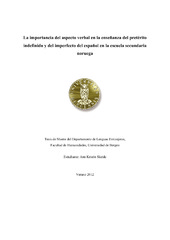| dc.contributor.author | Skeide, Ann-Kristin | eng |
| dc.date.accessioned | 2012-10-04T10:57:41Z | |
| dc.date.available | 2012-10-04T10:57:41Z | |
| dc.date.issued | 2012-05-14 | eng |
| dc.date.submitted | 2012-05-14 | eng |
| dc.identifier.uri | https://hdl.handle.net/1956/6102 | |
| dc.description.abstract | The present study involves the realization of an experiment that demonstrates the importance of verbal aspect in the teaching of the verbal tenses preterite and imperfect for second level students of Spanish in their first year of the Norwegian high school: Akademiet Bergen. In this school Vamos 1 (Textbook and Studybook) are used as teaching books for second level students who are in their first year of Spanish. The grammar sections of these books do not explain anything about the verbal aspect, nor do they provide exercises that help students develop an understanding of the term. My hypothesis is that this might be the reason why Norwegian students struggle to understand the difference between these two preterites. The aim of the present study is to verify that by making use of different teaching material than that of Vamos 1, more precisely visual material that explain both tense and aspect, the students will develop a better understanding and appliance of the preterite and the imperfect. | en_US |
| dc.description.abstract | El proyecto de este trabajo es la realización de un experimento que muestra la importancia del aspecto verbal en el aprendizaje de los tiempos verbales; pretérito indefinido y pretérito imperfecto para los alumnos del segundo nivel del español en el primer año del instituto secundario noruego; Akademiet Bergen. En este instituto usan los libros Vamos 1 (libro de texto y libro de ejercicios) para la enseñanza del español a los alumnos del segundo nivel en el primer año. En la parte de la gramática, que trata del pretérito indefinido y el imperfecto, Vamos 1 no explica nada sobre lo que significa el aspecto verbal. Tampoco ofrece ejercicios para que los alumnos mismos desarrollen un entendimiento sobre el aspecto. Mi hipótesis es que esa puede ser la causa por la que los alumnos no entienden bien la diferencia entre estos dos tiempos verbales. El proyecto de investigación pretende constatar si al utilizar herramientas distintas de las que se usan en Vamos 1, y a través del uso de estas, se puede explicar tanto el tiempo como el aspecto verbal, confirmar si los alumnos entienden mejor la diferencia entre el pretérito indefinido y el imperfecto, y si llegan a aplicar mejor estos tiempos verbales. | en_US |
| dc.format.extent | 40731 bytes | eng |
| dc.format.mimetype | application/pdf | eng |
| dc.language.iso | spa | eng |
| dc.publisher | The University of Bergen | eng |
| dc.subject | Pretérito | es |
| dc.subject | Aspecto | es |
| dc.subject | Enseñanza | es |
| dc.title | La importancia del aspecto verbal en la enseñanza del pretérito indefinido y del imperfecto del español en la escuela secundaria noruega | es |
| dc.type | Master thesis | |
| dc.rights.holder | Copyright the author. All rights reserved | |
| dc.description.degree | Master i Spansk språk og latinamerikastudier | |
| dc.description.localcode | MAHF-SPLA | |
| dc.description.localcode | SPLA350 | |
| dc.subject.nus | 711128 | eng |
| fs.subjectcode | SPLA350 | |
